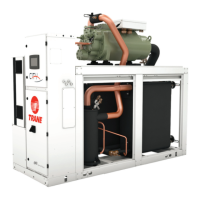43
RLC-SVX023B-GB
Maintenance Procedures
Removing Compressor Oil
The oil in the compressor oil separator is under a constant positive pressure at ambient temperature. To remove oil,
open the service valve located on the bottom of the oil separator and drain the oil into a suitable container using the
procedure outlined below:
CAUTION: POE Oil!
Due to the hygroscopic properties of the POE oil, all oil must be stored in metal containers. The oil will absorb water
if stored in a plastic container.
Oil should not be removed until the refrigerant is isolated or removed.
Connect a line to the oil sump drain valve.
Open the valve and allow the desired amount of oil to fl ow into the container and close the charging valve.
Measure the exact amount of oil removed from the unit.
Oil Charging Procedure
It is critical to fi ll the oil lines feeding the compressor when charging a system with oil. The diagnostic “Loss of oil at
the compressor stopped “ will be generated if the oil lines are not full on start-up.
To properly charge the system with oil, follow the steps below:
1. Locate the 1/4 “ schrader valve on the end of the compressor.
2. Loosely connect oil pump to schrader valve called out in step 1.
3. Operate oil charging pump until oil appears at the charging valve connection; then tighten the connection.
Note: To keep air from entering the oil, the charging valve connection must be air-tight.
4. Open the service valve and pump in the required amount of oil.
5. Monitor the “Oil Loss Level Sensor Status in TD7 in Compressor status view. This display shows whether
the optical sensor is seeing oil (wet) or if it is not (dry).
NOTE: The remainder of the oil charge can be charged into the 1/4 “ service valve located at the bottom of
the separator if a larger connection is preferred.
Replacing the Main Oil Filter (Hot Filter)
The fi lter element should be changed if the oil fl ow is suffi ciently obstructed. Two things can happen: fi rst, the chiller
may shut down on a “Low Oil Flow “ diagnostic, or secondly, the compressor may shut down on a “Loss of Oil at
Compressor (Running) diagnostic. If either of these diagnostics occurs, it is possible the oil fi lter needs replacement.
The oil fi lter is not usually the cause of a Loss of oil at Compressor diagnostic.
Specifi cally, the fi lter must be changed if the pressure drop in the lubrication circuit exceeds the maximum level as
given in Figure 10 below. The charts show the relationship between the pressure drop measured in the lubrication
circuit as compared with operating pressure differential of the chiller (as measured by pressures in the condenser
and evaporator).
Normal pressure drops of the lubrication circuit are shown by the lower curve. The upper curve represents the
maximum allowable pressure drop and indicates when the oil fi lter must be changed. Pressure drops that lie
between the lower and upper curves are considered acceptable.
For a chiller equipped with an oil cooler, add 35 kPa to the values shown in Figure 10. For example, if the system
pressure differential was 550 kPa, then the clean fi lter pressure drop would be approximately 100 kPa (up from 70 kPa
For a chiller with an oil cooler and operating with a dirty oil fi lter, the maximum allowable pressure drop would be
190 kPa (up from 160 kPa).
Under normal operating conditions the element should be replaced after the fi rst year of operation and then as
needed thereafter.

